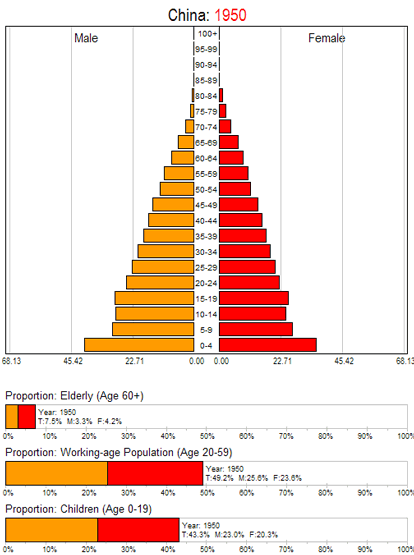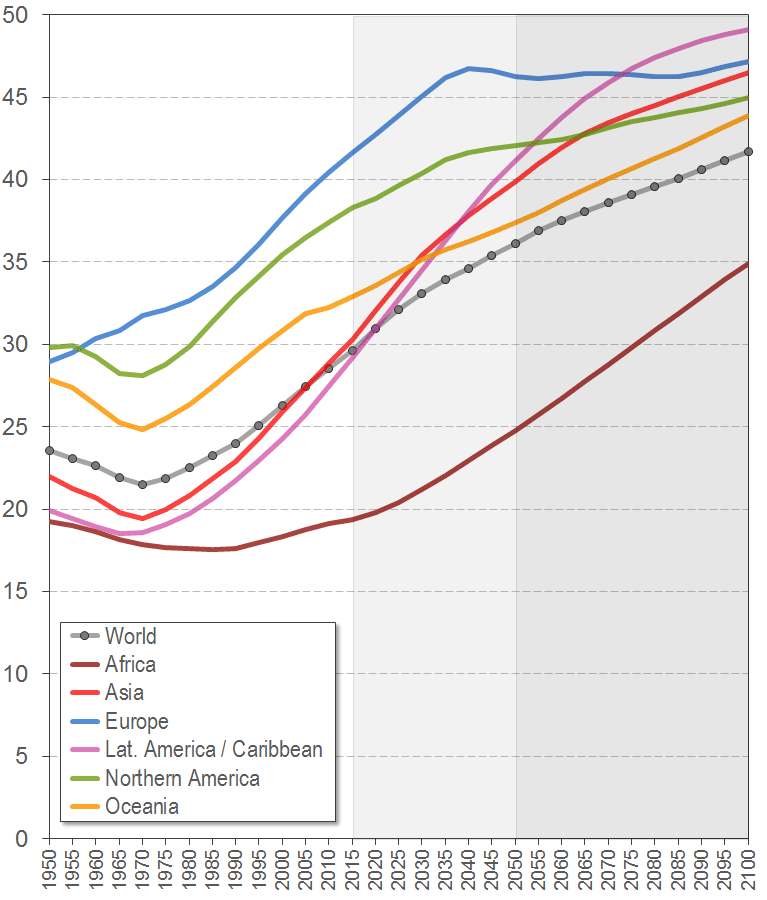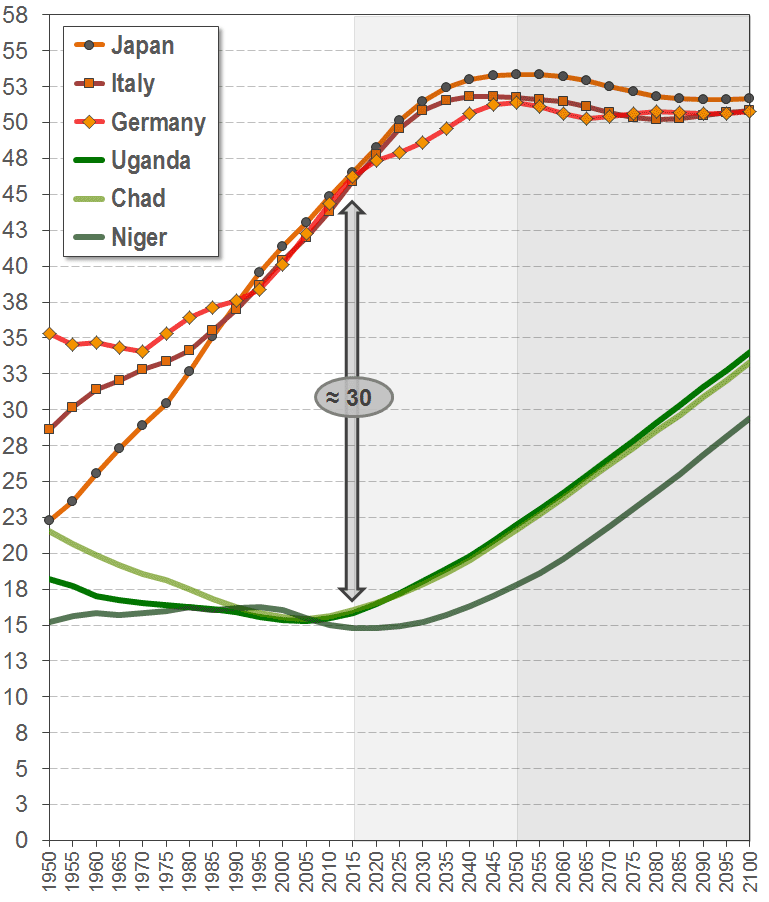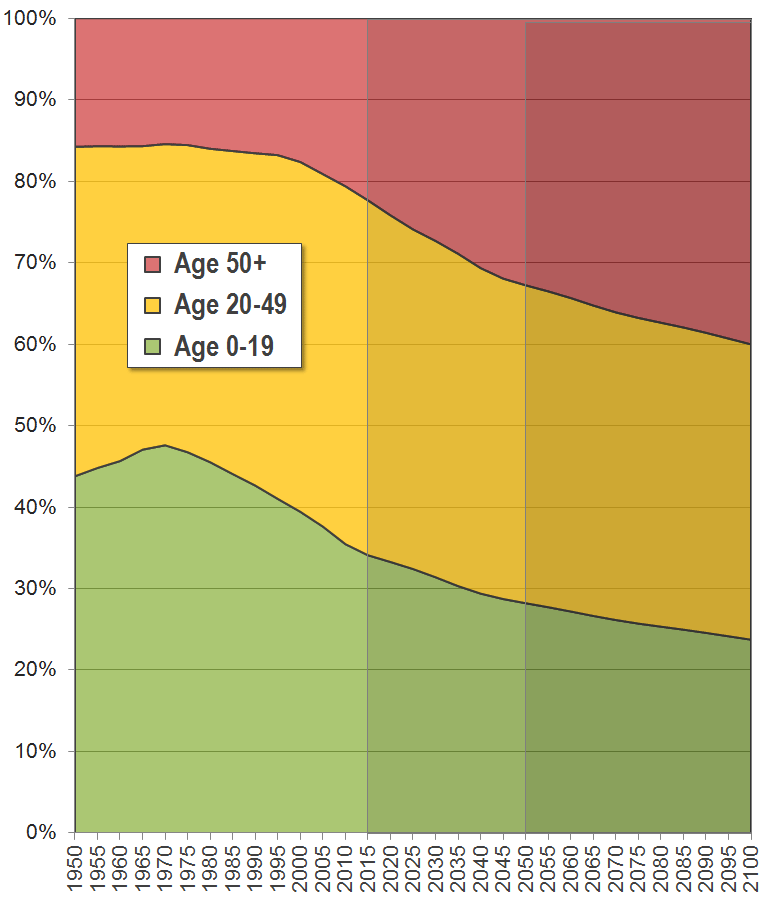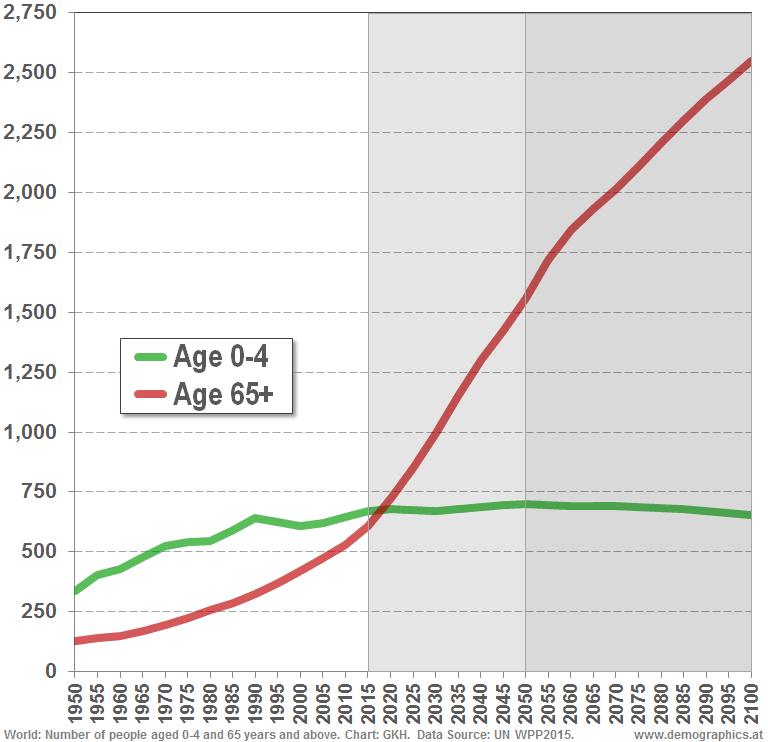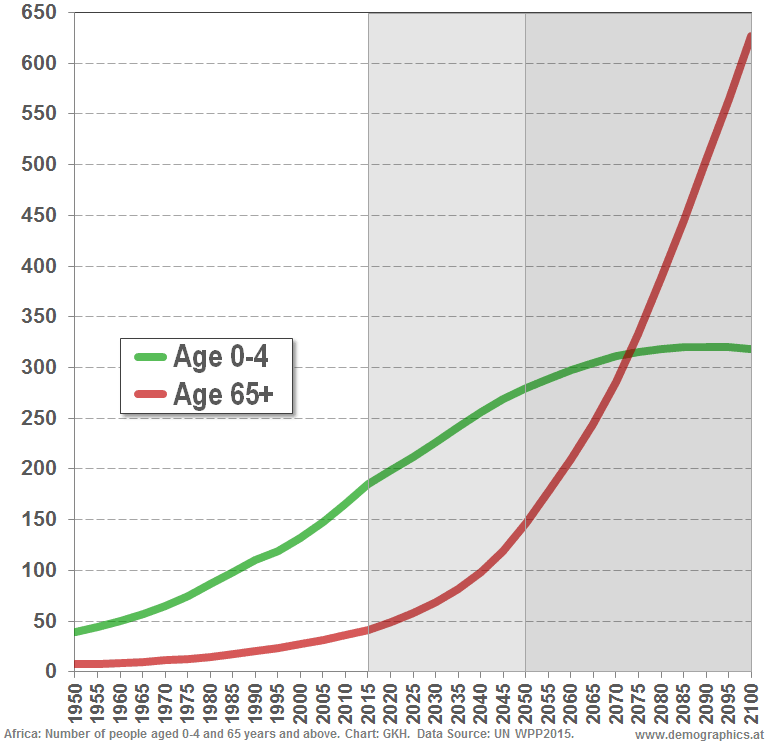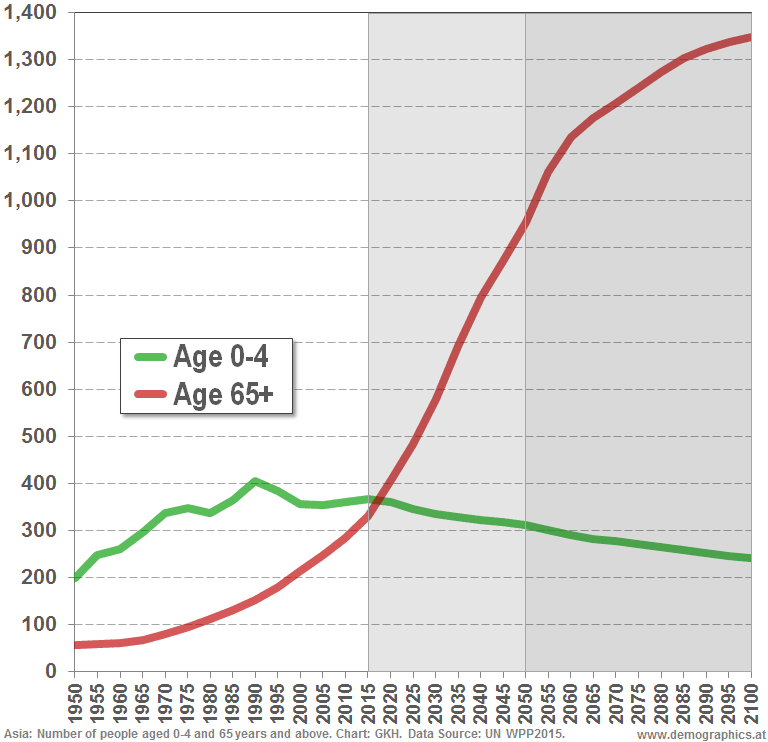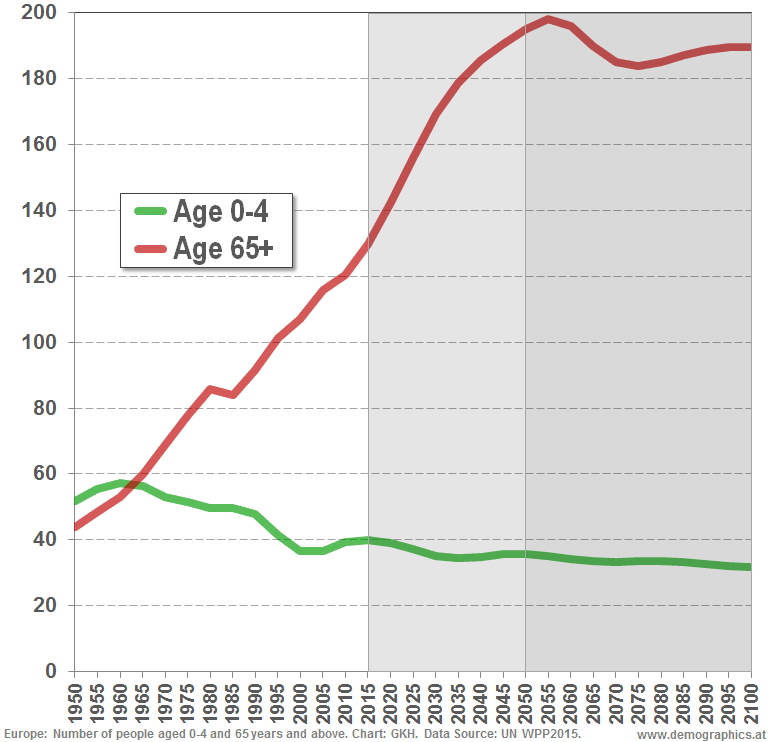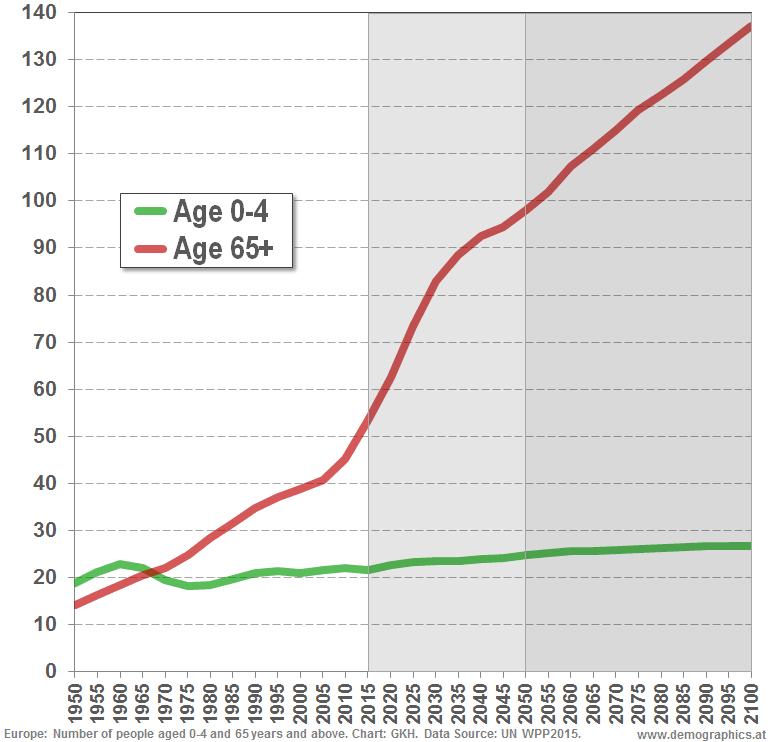
Population aging is a decline in the proportion of young people and a corresponding increase in the proportion of older people in a population - as illustrates in the animation of Chinas demographic transition above.
For example, in 1950, China's population had a very high percentage of children and young people - more than 43 percent of the population was under the age of 20 (see figure above). At that time the proportion of people age 60 and above was only 7.5 percent.
This very young age composition of the Chinese population changed significantly when fertility began to decline. Particularly after the mid-1970s and in the 1980s, when average fertility dropped due to the county's strict "one-child" family planning program, the population began to age.
By the turn of the century, China's age composition had already aged considerably. Now only about 34 percent of the population were children and young adults under the age of 20, but the percentage of working age population age 20 to 64 had increased to 56 percent. The percentage of older people, age 60 and above, had increased to 10 percent.
But this was only the first stage in China's population ageing. By 2050, the proportion of children and young adults under the age of 20 will be less than half what it was in 1950 - only 18 percent as compared to 43 percent. More than one third of the population will then be older people age 60 and over.
If fertility remains low in China for the rest of the century (as expected) than almost 4 out of 5 people in China will be 20 years of age or older by 2100. More than one third (34 percent) of the population will be 60 years of age or older.
In 1970 the world population was much younger than today - half the population of the world was younger than 21.5 years. By 2015 the median age of the world's population had increased to more than 29.6 years and by the end of the twenty-first century half the population of the world will be older than 42 years.
Currently, Europe's population is, by far the oldest. In 2015, the median age was already 41.7 - up from less than 30 in 1950. Without any doubt, Europe's population will continue to age - at least for several decades. By 2040 the median age of Europe's population will peak at more than 46 years. Then the median age might slightly decline to about 45 years of age - assuming that Europe's population will have slightly higher fertility than in 2010 (without such an increase, the population would age even more).
It may be surprising, but the fastest process of population ageing was estimated not for Asia, but for Latin America. In 1965 Latin America had one of the youngest populations of all major regions - almost as young as that of Africa. Half the population of Latin America was younger than 19 years of age. But since then the population had been ageing rapidly. By 2010 half the population of Latin America was already almost 28 years; and over the next four decades the population will age further. By 2050 half the population will be older than 40 years. If the projections are correct, Latin America will have the oldest population of all major regions by the end of the twenty-first century: Fifty percent of the population will then be older than 46 years.
Africa's population is, by far, the youngest of all major regions: By 1985 half of the continent's population was younger than 18 years of age. Today, the median age is around 20 - about the same as in 1950. But in coming decades Africa's population will also age. Africa's population aging, however, will be more slowly and at a much lower level than in all other major regions of the world. By 2050 half of Africa's population will be older then 26 years - assuming that Africa has the projected fertility decline. And if fertility declines even further after 2050 Africa's median population age could be around 36 years by the end of the twenty-first century - still by far the youngest of all major regions.
Currently (2015), the population in Uganda, Chad and Niger has a median age of between 15 and 16. On the other hand, the population in Japan, Italy and Germany has a median age of around 46 years. Thus the median age in Japan, Germany and Italy is roughly 30 years higher than in the selected African countries.
It may be surprising, but the fastest process of population ageing was estimated not for Asia, but for Latin America. In 1965 Latin America had one of the youngest populations of all major regions - almost as young as that of Africa. Half the population of Latin America was younger than 19 years of age. But since then the population had been ageing rapidly. By 2010 half the population of Latin America was already almost 28 years; and over the next four decades the population will age further. By 2050 half the population will be older than 40 years. If the projections are correct, Latin America will have the oldest population of all major regions by the end of the twenty-first century: Fifty percent of the population will then be older than 46 years.
Because of the projected fertility decline the median age of Uganda, Chad and Niger should also increase in the future. However, by 2050 the median age of these countries might be still only at the same level as in Italy around 1950. African countries, in general, will have extremely young population in the forseeable future due to their still high level of fertility
Some 44% of the world population in 1950 were children and young people under the age of 20; roughly 42% were people age 20 to 49 years; and about 15% were people age 50 and over. Today (in 2015), children and young people under 20 are only 34% of the world population, while the percentage of people age 50 or above has increased to 23%.
By the end of the 21st Century almost 40% of the world population could be people age 50 and above; at that time, children and young people under 20 could be less thean 25% of the world population (See figure above)
The rapidly declining percentage of children and young people in the world population, together with the increase in the proportion people age 50 and above, clearly illustrates the worldwide process of population aging.
This is the consequence of rapidly declining fertility in many parts of the world combined with growing life expectancy (and also relative large birth cohorts before the fertility decline).
Within only a few decades there will be twice as many elderly (age 65 and above) than children under age 5.
By the end of the 21st century the number of elderly age 65 and above may be four times as large as the number of children under five.
There are about 185 million children under the age of five and about 42 million people age 65 and above.
By 2050, there will be three times more elderly than young children in Asia.
By the end of the century, Asia might have 5.6 times more elderly age 65 and above than young children under age 5 - 1.35 billion as compared to 32 million.
Today, there are about 130 million people aged 65+ in Europe - more than three times as many as young children (under age five).
By the end of the century, it is quite possible that Europe will have almost 190 million people age 65+, but less than 32 million young children (under age five).
However, already by 2050, there will be 3.5 times more elderly than young children in Latin America.
By the end of the century, Latin America might have 6.8 times more elderly than young children - 227 million vs. 33 million.
However, in only a few decades Northern America will have far more people age 65 and above: 98 million. The number of children under age five will be only 25 million.
By the end of the century, Northern America might have more than five times more elderly (aged 65+) than young children (under age five) - 137 million vs. 27 million.
a) A sustained decline in fertility;
b) a decline in mortality - particularly a decline in adult mortality or mortatlity at higher ages - corresponding to an increase in life expectancy;
c) a net-immigration of "older" people.
Each of these factors can cause population aging - either one factor alone, or two and three factors together in variing contributions.
Contrary to popular belief, population aging is not always related to an increase in life expectancy. It is quite possible for a population to age through a sustained decline in fertility without any contribution from declining mortality or immigration of older people. In the figure above we can see a high correlation between fertility decline and the increase in median age of the population for all countries of the world.
Population aging in Asia and Latin America is predominantly caused by the rapid decline of fertility since the 1970s. This decline is responsible for birth cohorts that have increased more slowly than expected or have even declined in size. This has subsequently lowered the share of younger age groups relative to older age groups in those populations - the process called population ageing. As soon as fertility will decline more significantly in Africa, population aging will also take place among African populations.
Rapid population aging in Europe and some of the highly developed Asian countries is also due to the decline of fertility - even if increasing life expectancy has contributed to the process.
Sustained sub-replacement fertility - particularly lowest-low fertility of only some 1.3 children per woman - is a key factor of population aging, because it eventually leads to a progressing decline in the number of births - and thus progressive shrinking of younger age groups in the population.
The political debate about population aging and the necessary adjustment of pension systems has been grossly misleading - particularly in German-speaking countries. Most people believe population ageing would be only a consequence of higher life expectancy - largely ignoring the impact of extremely low fertility. This is why the public debate has been focused on higher retirement age in order to take into account higher life expectancy. Policies for promoting higher birth rates are hardly ever considered due to political taboos and ideological blindness.
Even some demographers and economists have argued that low fertility is not a big problem because economic adjustments to population aging would be possible (Lee, Mason 2014).
Grant, Jonathan and Stijn Hoorens, Suja Sivadasan, Mirjam van het Loo, Julie DaVanzo, Lauren Hale, Shawna Gibson, William Butz (2004) Low Fertility and Population Ageing. Causes, Consequences, and Policy Options. RAND Europe. Prepared for the European Commission.
Lee, Ronald and Andrew Mason (2014) Is low fertility really a problem? Population aging, dependency, and consumption. In: Science, Vol. 346, Issue 6206, 229-234. DOI: 10.1126/science.1250542
